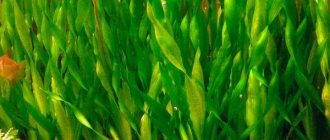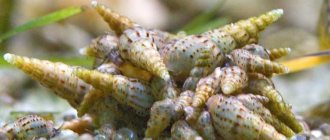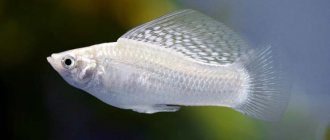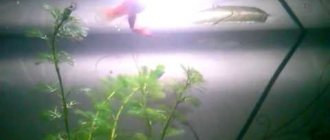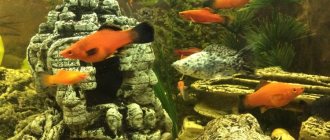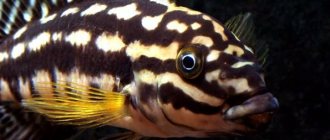Achatina fulica (Achatina fulica)
Achatina fulica - Achatina fulica
Fulica lives in a tropical climate. The length of the mollusk is 20 cm. In a terrarium it grows up to 17 cm. The shape of the shell is conical with 6-9 turns. Body color is beige, light brown, less often black. The structure of the sole is coarse-mesh. Read more about housing and feeding here .
The color of the shell varies from dark brown to red. As the shell ages, it develops dark streaks and blurring. Apex brown, less often sandy, pointed. Columella is white or bluish in color.
Achatina Fulica umbilicata Neville
The snail does not require constant care and is inexpensive to maintain, which is why novice terrarium keepers choose it. The snail is omnivorous and gluttonous. Loves water, but does not tolerate waterlogging in the terrarium.
Active at temperatures from 20 to 28 degrees and humidity from 65% to 75%. In captivity, it lives up to 8 years. Achatina fulica becomes sexually mature at 5-6 months, with a clutch of 250 to 700 eggs. Egg size is 5-6 mm.
Achatina Fulica rodatzi Dunker
The fulika moves calmly and slowly. Watching her calms her down. In the first half of the day, she chooses a quiet place and takes a nap there. She is timid and makes a squeak when she hides in a shell. With poor care, it hibernates for up to 9 months.
In a community of relatives, compliant and friendly. The snails eat in turns, without interfering with each other. To keep 1 fulika, a terrarium volume of at least 15 liters is required.
Achatina Fulica sinistrosa Grateloup
Varieties of Achatina fulica:
- Achatina Fulica hamillei Petit
- Achatina Fulica rodatzi Dunker
- Achatina Fulica sinistrosa Grateloup
- Achatina Fulica umbilicata Neville
Achatina Fulica hamillei Petit
Snail nutrition
Snail food is determined by its habitat. As a rule, their diet is extremely varied. These mollusks are consumed as food:
- Remains of rotten plants;
- Non-solid plants;
- Worms;
- Carrion;
- Fish;
- Your relatives;
- Insects;
- Crustaceans.
Land mollusks adhere to a vegetarian diet. Their diet mainly consists of various leaves, fruits and berries, vegetables and herbs. Young snails eat fresh leaves, but as they age, they prefer already rotten plants.
Achatina reticulata
Achatina reticulata -
Also a popular species among snail breeders. She is originally from Zanzibar. The length of the corrugated shell is 18 cm. The color of the shell ranges from light beige to brown with dots and axial stripes. The apex is beige or sandy, the collumella is white. The body and head of the reticulum are beige or brown, and the edges of the sole are light. Read more about care and reproduction in our article .
See more similar articles:
Large African snail - Achatina Fulica (Achatina...
Achatina - African giant snail
Back Forward 1 of 6
The snail is active, sociable and curious. Always cranes his head to keep abreast of events. She is smart, learns quickly, and you can easily teach her to eat by the hour. Gluttonous, eats everything.
Achatina reticulata dark head
Active even in the first half of the day, becomes attached to the owner and distinguishes him from strangers. Favorable temperature for life is from 25 to 27 degrees and humidity from 60% to 75%. In captivity, it lives up to 6 years. At 10-12 months the snail becomes sexually mature; the clutch contains 300 eggs, 7-8 mm each.
Albino snails are valued among snail breeders. This variety of reticulata albino is smaller in size and grows slower than its counterparts. Their length is 15 cm. The color of the body and head is white. The color of the shell, apex and columella is milky white. Mobile, active mollusks easily come into contact with humans.
Achatina reticulata albino
To keep Achatina reticulata you need a terrarium with a volume of 20 liters.
Varieties of Achatina reticulata:
- Achatina reticulata light head
- Achatina reticulata dark head
- Achatina reticulata albino
Achatina reticulata light head
Snail breeding
The method of reproduction of snails is determined depending on their affiliation. For example, many gastropod snails are primarily oviparous animals. And the fertilization process itself is determined by the habitat.
Snails that are endowed with lungs and live in water or land are considered hermaphrodites. They have two principles: male and female. Freshwater species lay eggs in capsules, while land species lay eggs in small holes. One clutch can produce 85 eggs. Their ripening process does not exceed 28 days.
Achatina immaculata
Achatina immaculata - Achatina immaculata
Immaculata is similar to fulica. Her homeland is Tanzania. She is popular as a pet. Unpretentious, omnivorous and beautiful. See more useful information about immaculata here .
The length of the plump conical shell is 12 cm with 5-6 rounded turns, like a “striped watermelon”. The color of the shell varies from light brown to dark brown with even stripes. Apex beige or sand. Achatina immaculata is distinguished by its pink-violet columella. To see this, pull back the snail's mantle slightly.
Achatina immaculata panthera
The body of the immaculata is light beige, thicker and larger than that of the fulik, with a characteristic stripe on the neck.
The snail grows well and reaches sexual maturity at 9 months, laying 150 eggs of 6 mm each. Unusually, it reproduces by self-fertilization. 25 - 27 degrees is a comfortable temperature for living. Humidity 75%-80%.
Achatina immaculata var. panthera
Among snail breeders, immaculata panthera . The content is an unpretentious snail. Sociable and friendly. It can sometimes hibernate in winter. It grows slowly and reaches 10-15 cm in length.
The body color is light pink with a peach stripe across the entire head. The sole is soft with a mesh pattern. The shell is light in brown stripes without blur and dots, conical in shape. The apex is light, the columella is crimson. With a lack of calcium, immaculate, the panther can gnaw on the shells of its neighbors. The volume of the terrarium for 1 Achatina immaculate is 15 liters.
Achatina immaculata Smitty - Achatina immaculata var. smithii
Varieties of Achatina immaculata:
- Achatina immaculata var. smithii
- Achatina immaculata var. panthera
- Achatina immaculata var. immaculata "two-tone"
Achatina immaculata immaculata “two-tone”
Walks
Land snails do not need walks, like other domestic animals, and fresh air has a very good effect on them - the gastropods' appetite improves and activity increases. They are taken outside on a cool day in a container. A very short walk is enough for them - only about half an hour. At this time, you must carefully ensure that the snail’s skin does not dry out; for this, it is recommended to spray it with water from time to time. Also protect the container from direct sunlight.
There is no need to let your pets out onto the grass - land snails can attract predators and also become infected with parasites. These are very fragile creatures that are difficult to treat, since it is very difficult to find a veterinarian for such a pet. In any case, there is no need to risk their health and life.
Achatina albopicta
Achatina albopicta - Achatina albopicta
Albopicta is similar to Achatina reticulata. Tanzania and Kenya are its homeland. The ribbed shell reaches 16 cm, the color is marbled with brown veins. A characteristic difference is that the columella is white or yellow. Apex pink or white. More useful information about albopicte here . The mollusk grows quickly, reaching 12 cm in six months.
Achatina albopicta - Achatina albopicta
It is not a demanding, omnivorous and friendly pet. The temperature in the terrarium is 26-29 degrees, and the humidity is 80%-90%. Leads a nocturnal lifestyle. During the day he buries himself in the litter and sleeps.
Reaches sexual age at 9 months, in a clutch of 250 eggs of 5 mm each. The volume of the terrarium for 1 Achatina albopicta is 20 liters.
Achatina albopicta - Achatina albopicta
Benefit
Like all snails, ampullaria are useful inhabitants of an aquarium. They clean the walls of their home, eat the remaining food and garbage, and also, of course, decorate the water kingdom with their colorful appearance.
Some owners claim that snails of this genus eat low-quality algae, thereby saving other inhabitants from harmful substances.
Lemon Achatina (Achatina iredalei)
Lemon Achatina - Achatina iredalei
Iradelie comes from Zanzibar. The conical shell measures 6 cm with 4 turns. This species received its name for the lemon-yellow color of the shell and the cream color of the sole. The color of the head is darker than that of the sole. The apex is sandy or yellow, the columella is yellow.
This snail is viviparous (does not lay eggs). It becomes sexually mature at 7 months, and 25 snails, each 1 cm in size, are born every six months.
Akhatina Iradelie
She is active, sociable and curious, unpretentious to the conditions of detention. Loves water and tasty food. 23-28 degrees is the optimal temperature for lemon snail. Humidity 70%-90%.
It is nocturnal, squeaks, rustles and eats. Distinguishes the owner from strangers. She loves to be held. The volume of the terrarium for lemon Achatina is 10 liters.
Varieties of Achatina iradelei:
- Achatina iredalei albino
Achatina iredalei albino
General characteristics of snails
The snail is a unique creature that is well adapted to life in nature, and is also quite often found as a pet. By origin, snails are mollusks and belong to the category of gastropods.
Characteristic
The snail is distinguished by its structure. As a rule, their body consists of several parts: head, leg, visceral sac and mantle fold. The movement of snails is carried out using the sole, which is located on the back of the leg. Direct movement occurs through wave-like muscle contractions. To glide quickly and easily, snails produce a large amount of mucus.
The structure of a snail shell is presented in the form of several layers:
- The periostracum is a rather thin outer layer of the shell;
- Ostracum - located in the middle of the shell and contains calcium carbonate;
- The hypostracum is the innermost layer, also consisting of calcium carbonate.
Snail mucus has a unique composition that is of great importance for the life of the mollusk. Mucus contains only mucin protein and water. This mucus is widely used in several areas of human life. For example, today it is used in cosmetic procedures. It helps rejuvenate and moisturize skin cells.
Brown Achatina (Achatina glutinosa)
Brown Achatina - Achatina glutinosa)
The snail is similar to the immaculate panther and fulica. Mozambique and Malawi are her homeland. The size of the mollusk reaches 12 cm. The shell is massive, ovoid-conical in shape, dark brown in color with brown stripes. Apex brown, slightly rounded. Columella is white or blue.
The body is massive, gray-brown with a darkened stripe on the head. With good care it grows quickly. He loves water and swimming, combining communication with the owner and water procedures.
Achatina glutinosa
Brown Achatina is sociable, omnivorous and active - even in the daytime. The optimal temperature is 25 - 28 degrees. Humidity 65% - 70%.
Rarely found in home terrariums. It becomes sexually mature at 7 months, with a clutch of 300 eggs. The volume of the terrarium for brown Achatina is 15 liters.
Achatina glutinosa
Habitat
Platymma tweediei is the largest land snail in Peninsular Malaysia. It is endemic to Malaysian montane cloud forests.
Fire snails have been found in the Cameron Highlands area of Pahang, as well as near Temengor Forest Reserve and Pergau River in Kelantan.
The habitat of representatives of this species is very limited. They can only be found in certain mountainous areas, more than 1000 meters above sea level, with high humidity and cold air. Due to the large number of streams and springs, this area is covered in fog. In summer, the air temperature does not rise above 27°C, and in winter it drops below 10°C.
Achatina "tiger" or common Achatina (Achatina achatina)
Common Achatina - Achatina achatina
The largest species of African snail. At home in Nigeria, its size reaches 33 cm. However, in captivity it grows up to 25 cm. The weight of the mollusk is 400 grams. The color of the barrel shell varies from lemon yellow to tan, with black-brown stripes and dots. The apex is yellow, the columella is crimson or pink. There is a separate article on the site dedicated to the tiger snail - read .
Achatina "tiger" - Achatina achatina
The body color is black or brown, but there are also albinos with white legs. They are calm and lazy by nature and prefer to sit in one place. They sleep a lot in the bedding, distracted only by food. Slow and unsociable.
Achatina achatina
They are demanding on nutrition and living conditions and grow slowly. They reach sexual maturity at 2 years, in a clutch of 100 eggs of 7 mm each.
Achatina Аchatina Albino
Content temperature 26-30 degrees. Humidity 70%-90%. It is rare to find snail breeders in terrariums. The volume of a terrarium for an Achatina tiger is 30 liters. Albinos require special care, see here .
Achatina achatina roseolabiata depravata
Exotic dishes are prepared from the meat of Achatina vulgaris. Its meat is believed to cure tuberculosis.
Varieties of Achatina Achatina:
- Achatina Аchatina Albino
- Achatina achatina roseolabiata depravata
- Achatina achatina elegans monochromatica togënsis bayoli
Achatina achatina monochromatica togënsis bayoli
How to feed
When purchasing any pet, it is important to understand what these representatives of the animal world eat. Aquarium snails are one of the most grateful pets in this sense, because they are practically omnivorous.
They will happily eat everything that can fit in their mouth without any whims. With the amount of food, everything is also extremely simple: it is very difficult to overfeed a slimy pet, however, a large amount of food will quickly pollute the water in the aquarium, so you should not overdo it with food.
What to feed Ampularia in the aquarium?
Any fish food or natural food is suitable as food for the “horned cats”: worms, insects, cabbage, vegetables and herbs.
Important! When feeding aquarium inhabitants, it is necessary to ensure that all animals have enough food, because quick fish absorb food much faster than slow snails.
Achatina zanzibarica
Achatina zanzibarica
As the name suggests, the snail comes from Zanzibar. In captivity it grows up to 12. The cone-shaped shell is straw-yellow in color with brown stripes and dots. But there are Zanzibaris with a pure yellow shell. Apex pink, pointed. Columella is white and blue. The snail's body is beige or light brown with a mesh pattern.
Achatina Zanzibarica is viviparous (does not lay eggs). It becomes sexually mature at 8 months, and 30 snails measuring 7 mm in size are born once a year. The optimal temperature is 25 - 28 degrees. They love warm soil. Humidity 70%-80%.
Achatina zanzibarica
They are rarely found in home terrariums, as they are capricious in maintenance. They gnaw each other's shells and often go into hibernation.
Achatina zanzibarica albino
With proper care, the Zanzibarka grows quickly and eats well. Active and curious, they love to swim. During the daytime, they sleep buried in the ground. In captivity they live up to 6 years. The volume of the terrarium for the Achatina Zanzibarik is 15 liters.
Achatina zanzibarica
If you decide to keep different species of Achatina in one terrarium, pay attention to the compatibility table for different types of African snails.
Other types
Melania
He is a tank cleaner type, like all representatives of this breed. They eat the remains of rotten food at the bottom of the aquarium. The size does not exceed three centimeters. It has a gray-green shell color with dark stripes. They cannot tolerate low water temperatures in tanks, since in the wild their habitat is the tropics. They multiply quickly, which causes inconvenience, as they are difficult to breed. They spend most of their lives buried in the ground. The hard shell serves as a defense mechanism against predatory fish. They feed on settled fish food. If desired, you can include pieces of vegetables in your food.
Fiza
Has a small body size. It is useful for the aquarium because it cleans the walls of the tank from white deposits. The unusual shape of the shell allows it to penetrate into corners of the aquarium that are inaccessible to other inhabitants, and the presence of pulmonary respiration allows it to live in different habitats. The water temperature when kept is 22–24 degrees. Feeds on aquarium algae. The state of the gastropod's shell determines the level of acidity in the tank. Its elevated level leads to the destruction of the mollusk's protective word.
Is it worth buying
You should think carefully before purchasing this type. Because Platymma tweediei is endangered and is protected by the Convention on International Trade in Endangered Species of Wild Fauna and Flora.
Therefore, all representatives of Chemiplectae fiery, which can be found in private collections, are contraband. The cost of one such individual can vary between 100-200 euros.
